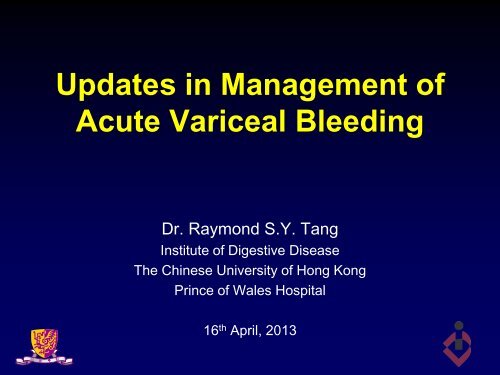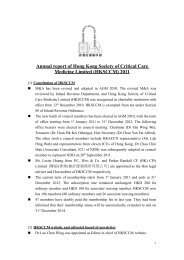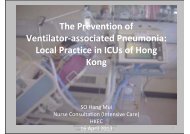Acute Variceal Bleeding
Acute Variceal Bleeding
Acute Variceal Bleeding
Create successful ePaper yourself
Turn your PDF publications into a flip-book with our unique Google optimized e-Paper software.
Updates in Management of<br />
<strong>Acute</strong> <strong>Variceal</strong> <strong>Bleeding</strong><br />
Dr. Raymond S.Y. Tang<br />
Institute of Digestive Disease<br />
The Chinese University of Hong Kong<br />
Prince of Wales Hospital<br />
16 th April, 2013
Outline<br />
• Significance<br />
• Management<br />
– Key issues<br />
– Established therapies<br />
– Emerging technologies
The Problem<br />
• Gastroesophageal Varices<br />
~ 40% in Child’s A cirrhosis<br />
~ 85% in Child’s C cirrhosis<br />
• <strong>Acute</strong> <strong>Variceal</strong> <strong>Bleeding</strong><br />
–1-year rate of 1 st variceal bleeding ~ 12%<br />
–1-year rate of recurrent bleeding ~ 60%<br />
–6-week mortality ~ 15 to 20%<br />
Garcia-Tsao G et al. Hepatology 2009<br />
Garcia-Tsao G et al. NEJM 2010
The Problem<br />
• Although mortality from variceal<br />
bleeding has decreased over the past<br />
2 decades due to:<br />
– Antibiotic prophylaxis<br />
– Improved endoscopic therapy and<br />
pharmacological therapy<br />
• Still a major potentially lethal<br />
complication of cirrhosis<br />
Carbonell N et al. Hepatology 2004
Varices<br />
Oesophageal<br />
Duodenal<br />
Gastric<br />
Rectal
Management of <strong>Acute</strong><br />
<strong>Variceal</strong> <strong>Bleeding</strong><br />
Initial Assessment &<br />
Resuscitation<br />
Pharmacological Therapy<br />
Endoscopic Therapy<br />
Rescue / Alternative Therapy
Initial Assessment &<br />
Resuscitation<br />
• Presentation:<br />
– Hematemesis Melena PR bleeding<br />
• Hemodynamic Stability:<br />
– Shock Tachycardia<br />
• Hemoglobin Level:<br />
– Target Hb (avoid over-transfusion)
Initial Assessment &<br />
• Level of Care:<br />
Resuscitation<br />
– ICU vs general ward<br />
• Airway Protection:<br />
– Consider intubation for patient with significant<br />
hepatic encelphalopathy
Blood Volume Resuscitation<br />
• Maintain hemodynamic stability<br />
• Avoid over-aggressive transfusion<br />
– Over-aggressive transfusion<br />
• Increase in portal pressure<br />
• More re-bleeding & mortality<br />
– Target Hb ~ 8 g/dL<br />
Castaneda B et al. Hepatology 2001
• Restrictive transfusion strategy (Tx if Hb < 7)<br />
vs Liberal transfusion strategy (Tx if Hb < 9)<br />
in 921 patients with UGIB<br />
• In subgroup analysis of 277 patients with<br />
cirrhosis<br />
– Reduced rate of re-bleeding & mortality in the<br />
restrictive transfusion group in Child’s A or B patients<br />
– No difference in Child’s C patients<br />
Vaillanueva et al. NEJM 2013
Management of Coagulopathy<br />
• FFP and/ or Platelets<br />
– Can be considered in patients with significant<br />
coagulopathy and/or thrombocytopenia<br />
• Recombinant Factor VIIa<br />
– No benefit in cirrhotic patients with UGIB in<br />
general<br />
– But post hoc analysis data shows reduced<br />
failure to control variceal bleeding in Child’s B,<br />
C patients<br />
Garcia-Tsao G et al. Hepatology 2009<br />
Bosch J et al. Gastroenterology 2004
Pharmacological Therapy<br />
• Vasoactive drugs<br />
• Antibiotic prophylaxis
Vasoactive Drugs<br />
• Somatostatin & Analogues<br />
– Octreotide & Vapreotide<br />
– Inhibits vasodilator hormones e.g. glucagon,<br />
+/- direct vasoconstricting property<br />
• Splanchnic vasocontriction<br />
• Vasopressin & Analogues<br />
– Terlipressin<br />
– Non-specific arteriolar vasoconstriction<br />
• Splanchnic vasocontriction
Vasoactive Drugs<br />
Regimen Dose Duration<br />
Octreotide<br />
IV 50ug bolus,<br />
followed by IV<br />
infusion of 50ug/h<br />
2 – 5 days<br />
Terlipressin 2mg IV Q4h x 48h,<br />
then 1mg IV Q4h<br />
2 – 5 days
Vasoactive Drugs as 1 st line therapy<br />
• A Cochrane metaanalysis<br />
of 15 RCTs<br />
– Sclerotherapy vs<br />
Vasoactive drugs as<br />
1 st line therapy<br />
– Vasoactive drugs is<br />
better, controlling<br />
bleeding in 83% of<br />
patients<br />
D'Amico G et al. Gastroenterology 2003
Early use of Vasoactive Drugs
Endoscopic <strong>Variceal</strong> Ligation (EVL)<br />
vs Octreotide + EVL<br />
EVL alone<br />
EVL + octreotide<br />
100<br />
94<br />
96<br />
80<br />
60<br />
40<br />
38<br />
P=0.0007<br />
20<br />
0<br />
Control of bleeding<br />
Rebleeding<br />
9<br />
Sung J et al. Lancet 1995
Antibiotic Prophylaxis<br />
• Cirrhotic patients with UGIB high<br />
risk of bacterial infection<br />
Higher risk of recurrent variceal bleeding<br />
Higher mortality<br />
• Antibiotic prophylaxis x 5 – 7 days<br />
–Ceftriaxone, Quinolones<br />
–Reduced bacterial infections (with or without<br />
ascites)<br />
–Increased survival<br />
Garcia-Tsao G et al. Hepatology 2009
Timing of Endoscopy<br />
• OGD within 12 hours of admission in<br />
cirrhotic patients with suspected<br />
variceal bleeding<br />
• Vasoactive drugs should be given<br />
before endoscopy if variceal bleeding<br />
is highly suspected<br />
Garcia-Tsao G et al. Hepatology 2009
Endoscopic Therapy<br />
Banding Ligation Injection Sclerotherapy Cyanoacrylate Obturation
Endoscopic Therapy +<br />
Pharmacological Therapy<br />
• Meta-analysis of 8<br />
trials<br />
– Improve initial & 5-day<br />
hemostasis<br />
– No difference in<br />
mortality or severe<br />
adverse events<br />
Bañares R et al. Hepatology 2002
Oesophageal Varices (OV)
Endoscopic Banding Ligation<br />
(EBL) vs Injection Sclerotherapy<br />
• Data from RCTs and Meta-analysis<br />
support EBL as the preferred therapy<br />
– Better initial control of bleeding<br />
– Less adverse events<br />
– Improved mortality<br />
Lo G et al. Hepatology 1997<br />
Villanueva et al. J Hepatol 2006<br />
Garcia-Pagan et al. Nat Clin Pract Gastroenterol Hepatol 2005
Endoscopic Banding Ligation<br />
(EBL) vs Injection Sclerotherapy<br />
• Sclerotherapy can be used in patients<br />
in whom EBL is not feasible<br />
Lo G et al. Hepatology 1997<br />
Villanueva et al. J Hepatol 2006<br />
Garcia-Pagan et al. Nat Clin Pract Gastroenterol Hepatol 2005
Endoscopic Banding Ligation (EBL)<br />
vs Cyanoacrylate Obturation<br />
• Conflicting data from 1 small<br />
prospective case series & 2 small<br />
randomized studies<br />
– Ljubicic et al reported no significant difference in<br />
terms of acute OV bleeding control, re-bleeding rate,<br />
and mortality<br />
– Santos et al reported more minor complications, OV<br />
recurrence, and a trend towards more re-bleeding in<br />
Cyanoacrylate group<br />
Cipolletta L et al. Dig Liver Dis 2009<br />
Ljubicic N et al. Hepatogastroenterology 2011<br />
Santos M et al. Eur J Gastroenterol Hepatol 2011
Gastric Varices (GV)
Gastric Varices (GV)<br />
• Present in 20% of patients with<br />
cirrhosis<br />
– Isolated or in combination with OV<br />
• More severe bleeding than OV bleeding<br />
• Higher mortality than OV bleeding<br />
Garcia-Tsao G et al. Hepatology 2009
Classification of GV<br />
• GOV1:<br />
– GV is a continuation of<br />
OV along lesser curve<br />
– Same treatment as OV<br />
• IGV1:<br />
– If this is from splenic<br />
vein thrombosis, then<br />
splenectomy
Cyanoacrylate Obturation<br />
• Tissue adhesive<br />
– N-butyl-cyanoacrylate<br />
– Isobutyl-2-cyanoacrylate<br />
– Thrombin<br />
• <strong>Acute</strong> fundal GV<br />
bleeding<br />
– Better initial control of<br />
bleeding<br />
– Lower re-bleeding rate<br />
Sarin S et al. Am J Gastro 2002<br />
Lo G et al. Hepatology 2001
Cyanoacrylate Obturation vs<br />
Endoscopic Banding Ligation (EBL)<br />
• <strong>Acute</strong> GV bleed:<br />
– Similar initial control of bleeding by both<br />
– Less re-bleeding in the Cyanoacrylate<br />
Obturation group (23% vs 47%)<br />
Tan P et al. Hepatology 2006
Transjugular Intrahepatic<br />
Portosystemic Shunt (TIPS) for GV<br />
• Can be 1 st line therapy for<br />
uncontrolled GV bleeding<br />
if Cyanoacrylate<br />
obturation is not available<br />
• Initial hemostasis success<br />
~ 90%<br />
Garcia-Tsao G et al. Hepatology 2009
TIPS vs Cyanoacrylate Obturation in<br />
Prevention of GV re-bleeding<br />
• 35 patients in TIPS group vs 37 patients in<br />
Cyanoacrylate group<br />
• Less re-bleeding in TIPS group<br />
– 4 TIPS patients (11 %) and 14 cyanoacrylate patients<br />
(38 %) ( P = 0.014)<br />
• No difference in survival or complication rate<br />
Lo G et al. Endoscopy 2007
EUS guided Cyanoacrylate<br />
Injection<br />
• Advantages of EUS<br />
– Allow detection of “deep” varices not seen on luminal<br />
view<br />
– Allow treatment of bleeding varix even if luminal view<br />
is obscured by blood clot<br />
– Ensure intra-variceal injection<br />
– Allow real-time monitoring of variceal obturation
EUS guided Cyanoacrylate<br />
• Lee YT et al. GIE 2000<br />
Injection<br />
– 54 patients with GV bleeding treated with biweekly<br />
Cyanoacrylate injection under EUS monitoring<br />
– Less recurrent bleeding compared to “on-demand”<br />
Cyanoacrylate injection group<br />
• Romero-Castro R et al. GIE 2007<br />
– 5 patients with GV bleeding successfully treated with<br />
EUS-guided FNA needle injection of Cyanoacrylate
EUS guided Cyanoacrylate<br />
Injection + Coil Embolization<br />
• Binmoeller K et al. GIE 2011<br />
– 30 patients with fundal GV bleeding<br />
– Control of acute bleeding 100%<br />
– 4 patients had re-bleeding from non-variceal source<br />
– No distant “glue” embolization
GV <strong>Bleeding</strong> treated with EUS guided<br />
Cyanoacrylate Injection
Rescue / Alternative Therapy<br />
• TIPS<br />
• Shunt Surgery<br />
• Balloon Tamponade<br />
• Self-Expandable Metal Stents<br />
• Balloon-Occluded Retrograde<br />
Transvenous Obliteration<br />
• Liver Transplant
TIPS<br />
• Modern covered<br />
TIPS stents usually<br />
have longer patency<br />
• Usually a bridge to<br />
more definitive<br />
therapy ( e.g. liver<br />
transplant)
Early Use of TIPS in <strong>Variceal</strong><br />
<strong>Bleeding</strong><br />
• Garcia-Pagan et al. NEJM 2010<br />
– 63 patients with Child’s C or Child’s B cirrhosis and<br />
persistent variceal bleeding<br />
– Early TIPS (within 72h) vs EBL + B-blocker, after<br />
initial treatment with vasoactive drug + endoscopy
Shunt Surgery<br />
• Child’s A and B cirrhosis with<br />
uncontrolled variceal bleeding<br />
• Non-cirrhotic portal hypertension<br />
related variceal bleeding<br />
• Effective in preventing re-bleeding, but<br />
higher rates of hepatic encelphalopathy<br />
Garcia-Tsao G et al. Hepatology 2009
Balloon Tamponade<br />
• Sengstaken–Blakemore<br />
tube<br />
• Minnesota tube<br />
• Linton tube<br />
– Temporary measure for<br />
uncontrolled variceal bleeding<br />
– Complications:<br />
• Aspiration, migration, necrosis/<br />
perforation of esophagus<br />
Garcia-Tsao G et al. Hepatology 2009
Self-Expandable Metal Stents<br />
• Alternative to Balloon Tamponade or<br />
TIPS (contraindications to TIPS) in<br />
uncontrolled OV bleeding<br />
• Usually as a temporary measure<br />
(removable stents)<br />
• Not very useful for GV bleeding<br />
Wright G et al. GIE 2010<br />
Escorsell et al. Gastroenterol Res Pract. 2011
Balloon-Occluded Retrograde<br />
Transvenous Obliteration<br />
• For cardiofundal GV with<br />
dominant tributaries from the<br />
splenic vein or splenic hilum<br />
and terminate in the left renal<br />
vein (spontaneous splenorenal<br />
or gastrorenal shunts)<br />
• GV treated with sclerosants<br />
• However, may aggravate OV,<br />
ascites<br />
Caldwell S et al. Am J Gastro 2012
Summary<br />
• <strong>Variceal</strong> bleeding is still a major potentially<br />
lethal complication of cirrhosis<br />
• Early use of vasoactive drugs<br />
• Timely endoscopy<br />
• Tailor endoscopic therapy to the type of varix<br />
• Becoming familiar with benefits and risks of<br />
rescue / alternative therapies for<br />
uncontrolled variceal bleeding






